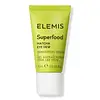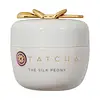What's inside
What's inside
 Key Ingredients
Key Ingredients

 Benefits
Benefits

 Concerns
Concerns

 Ingredients Side-by-side
Ingredients Side-by-side

Water
Skin ConditioningButylene Glycol
HumectantUrea
BufferingPropylene Glycol
HumectantGlycerin
HumectantAcrylates/Beheneth-25 Methacrylate Copolymer
Phenoxyethanol
PreservativeAcrylates/C10-30 Alkyl Acrylate Crosspolymer
Emulsion StabilisingSilica
AbrasiveChlorphenesin
AntimicrobialDisodium EDTA
Mentha Aquatica Leaf Extract
Skin ConditioningAlpha-Glucan Oligosaccharide
CleansingBoron Nitride
AbsorbentCucumis Melo Fruit Extract
Skin ConditioningPentylene Glycol
Skin ConditioningMica
Cosmetic ColorantSodium Dehydroacetate
PreservativeLactic Acid
BufferingSerine
MaskingSodium Lactate
BufferingSorbitol
HumectantChlorophyllin-Copper Complex
AntioxidantActinidia Chinensis Fruit Extract
EmollientCamellia Sinensis Leaf Powder
ExfoliatingTheobroma Cacao Extract
Skin ConditioningLeuconostoc/Radish Root Ferment Filtrate
AntimicrobialHelianthus Annuus Seed Oil
EmollientSodium Benzoate
MaskingSodium Chloride
MaskingCitric Acid
BufferingXanthan Gum
EmulsifyingSodium Hydroxide
BufferingAllantoin
Skin ConditioningPotassium Sorbate
PreservativeCI 77891
Cosmetic ColorantWater, Butylene Glycol, Urea, Propylene Glycol, Glycerin, Acrylates/Beheneth-25 Methacrylate Copolymer, Phenoxyethanol, Acrylates/C10-30 Alkyl Acrylate Crosspolymer, Silica, Chlorphenesin, Disodium EDTA, Mentha Aquatica Leaf Extract, Alpha-Glucan Oligosaccharide, Boron Nitride, Cucumis Melo Fruit Extract, Pentylene Glycol, Mica, Sodium Dehydroacetate, Lactic Acid, Serine, Sodium Lactate, Sorbitol, Chlorophyllin-Copper Complex, Actinidia Chinensis Fruit Extract, Camellia Sinensis Leaf Powder, Theobroma Cacao Extract, Leuconostoc/Radish Root Ferment Filtrate, Helianthus Annuus Seed Oil, Sodium Benzoate, Sodium Chloride, Citric Acid, Xanthan Gum, Sodium Hydroxide, Allantoin, Potassium Sorbate, CI 77891
Saccharomyces/Rice Ferment Filtrate
Skin ConditioningWater
Skin ConditioningGlycerin
HumectantPropanediol
SolventSqualane
EmollientDimethicone
EmollientBehenyl Alcohol
EmollientMyristyl Myristate
EmollientGlyceryl Stearate Se
EmulsifyingCera Alba
EmollientWhey Protein
Skin ConditioningInositol
HumectantSilica
AbrasiveCaprylic/Capric/Myristic/Stearic Triglyceride
EmollientCamellia Sinensis Leaf Extract
AntimicrobialCladosiphon Okamuranus Extract
Skin ConditioningPaeonia Albiflora Flower Extract
TonicHydrolyzed Silk
HumectantSericin
Skin ConditioningGeranium Robertianum Extract
AstringentChondrus Crispus Extract
Skin ConditioningYeast Ferment Extract
Skin ConditioningSargassum Vulgare Extract
Skin ConditioningSodium Hyaluronate
HumectantIsostearic Acid
CleansingSodium Stearoyl Glutamate
CleansingSodium Polyacrylate Starch
AbsorbentStearyl Alcohol
EmollientSorbitan Isostearate
EmulsifyingPolysorbate 60
EmulsifyingTocopheryl Acetate
AntioxidantTocopherol
AntioxidantHydroxyethyl Acrylate/Sodium Acryloyldimethyl Taurate Copolymer
Emulsion StabilisingSodium Benzoate
MaskingGluconolactone
Skin ConditioningButylene Glycol
HumectantEthylhexylglycerin
Skin ConditioningParfum
MaskingPhenoxyethanol
PreservativeCitral
PerfumingLimonene
PerfumingLinalool
PerfumingMica
Cosmetic ColorantTin Oxide
AbrasiveCI 77891
Cosmetic ColorantSaccharomyces/Rice Ferment Filtrate, Water, Glycerin, Propanediol, Squalane, Dimethicone, Behenyl Alcohol, Myristyl Myristate, Glyceryl Stearate Se, Cera Alba, Whey Protein, Inositol, Silica, Caprylic/Capric/Myristic/Stearic Triglyceride, Camellia Sinensis Leaf Extract, Cladosiphon Okamuranus Extract, Paeonia Albiflora Flower Extract, Hydrolyzed Silk, Sericin, Geranium Robertianum Extract, Chondrus Crispus Extract, Yeast Ferment Extract, Sargassum Vulgare Extract, Sodium Hyaluronate, Isostearic Acid, Sodium Stearoyl Glutamate, Sodium Polyacrylate Starch, Stearyl Alcohol, Sorbitan Isostearate, Polysorbate 60, Tocopheryl Acetate, Tocopherol, Hydroxyethyl Acrylate/Sodium Acryloyldimethyl Taurate Copolymer, Sodium Benzoate, Gluconolactone, Butylene Glycol, Ethylhexylglycerin, Parfum, Phenoxyethanol, Citral, Limonene, Linalool, Mica, Tin Oxide, CI 77891
 Reviews
Reviews

Ingredients Explained
These ingredients are found in both products.
Ingredients higher up in an ingredient list are typically present in a larger amount.
Butylene Glycol (or BG) is used within cosmetic products for a few different reasons:
Overall, Butylene Glycol is a safe and well-rounded ingredient that works well with other ingredients.
Though this ingredient works well with most skin types, some people with sensitive skin may experience a reaction such as allergic rashes, closed comedones, or itchiness.
Learn more about Butylene GlycolCi 77891 is a white pigment from Titanium dioxide. It is naturally found in minerals such as rutile and ilmenite.
It's main function is to add a white color to cosmetics. It can also be mixed with other colors to create different shades.
Ci 77891 is commonly found in sunscreens due to its ability to block UV rays.
Learn more about CI 77891Glycerin is already naturally found in your skin. It helps moisturize and protect your skin.
A study from 2016 found glycerin to be more effective as a humectant than AHAs and hyaluronic acid.
As a humectant, it helps the skin stay hydrated by pulling moisture to your skin. The low molecular weight of glycerin allows it to pull moisture into the deeper layers of your skin.
Hydrated skin improves your skin barrier; Your skin barrier helps protect against irritants and bacteria.
Glycerin has also been found to have antimicrobial and antiviral properties. Due to these properties, glycerin is often used in wound and burn treatments.
In cosmetics, glycerin is usually derived from plants such as soybean or palm. However, it can also be sourced from animals, such as tallow or animal fat.
This ingredient is organic, colorless, odorless, and non-toxic.
Glycerin is the name for this ingredient in American English. British English uses Glycerol/Glycerine.
Learn more about GlycerinMica is a naturally occurring mineral used to add shimmer and color in cosmetics. It can also help improve the texture of a product or give it an opaque, white/silver color.
Serecite is the name for very fine but ragged grains of mica.
This ingredient is often coated with metal oxides like titanium dioxide. Trace amounts of heavy metals may be found in mica, but these metals are not harmful in our personal products.
Mica has been used since prehistoric times throughout the world. Ancient Egyptian, Indian, Greek, Roman, Aztec, and Chinese civilizations have used mica.
Learn more about MicaPhenoxyethanol is a preservative that has germicide, antimicrobial, and aromatic properties. Studies show that phenoxyethanol can prevent microbial growth. By itself, it has a scent that is similar to that of a rose.
It's often used in formulations along with Caprylyl Glycol to preserve the shelf life of products.
Silica, also known as silicon dioxide, is a naturally occurring mineral. It is used as a fine, spherical, and porous powder in cosmetics.
Though it has exfoliant properties, the function of silica varies depending on the product.
The unique structure of silica enhances the spreadability and adds smoothness, making it a great texture enhancer.
It is also used as an active carrier, emulsifier, and mattifier due to its ability to absorb excess oil.
In some products, tiny microneedles called spicules are made from silica or hydrolyzed sponge. When you rub them in, they lightly polish away dead skin layers and enhance the penetration of active ingredients.
Learn more about SilicaSodium Benzoate is a preservative. It's used in both cosmetic and food products to inhibit the growth of mold and bacteria. It is typically produced synthetically.
Both the US FDA and EU Health Committee have approved the use of sodium benzoate. In the US, levels of 0.1% (of the total product) are allowed.
Sodium benzoate works as a preservative by inhibiting the growth of bacteria inside of cells. It prevents the cell from fermenting a type of sugar using an enzyme called phosphofructokinase.
It is the salt of benzoic acid. Foods containing sodium benzoate include soda, salad dressings, condiments, fruit juices, wines, and snack foods.
Studies for using ascorbic acid and sodium benzoate in cosmetics are lacking, especially in skincare routines with multiple steps.
We always recommend speaking with a professional, such as a dermatologist, if you have any concerns.
Learn more about Sodium BenzoateWater. It's the most common cosmetic ingredient of all. You'll usually see it at the top of ingredient lists, meaning that it makes up the largest part of the product.
So why is it so popular? Water most often acts as a solvent - this means that it helps dissolve other ingredients into the formulation.
You'll also recognize water as that liquid we all need to stay alive. If you see this, drink a glass of water. Stay hydrated!
Learn more about Water